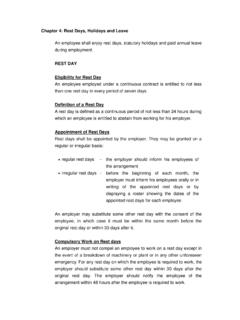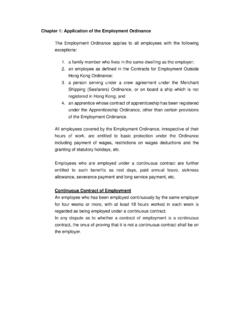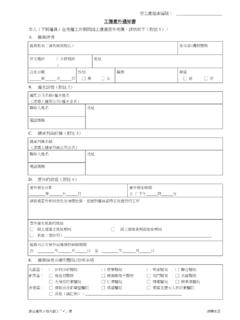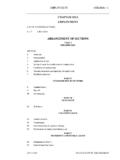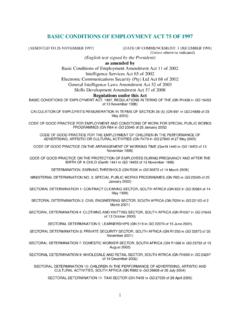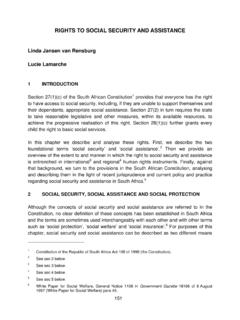Transcription of Chapter 2: Contract of Employment - labour.gov.hk
1 Chapter 2: Contract of Employment A Contract of Employment is an agreement on the Employment conditions made between an employer and an employee. The agreement can be made orally or in writing and it includes both express and implied terms. Employers and employees are free to negotiate and agree on the terms and conditions of Employment provided that they do not violate the provisions of the Employment Ordinance. Any term of an Employment Contract which purports to extinguish or reduce any right, benefit or protection conferred upon the employee by this Ordinance shall be void. Information on Conditions of Service Before Employment begins, an employer must inform each employee clearly of the conditions of Employment under which he is to be employed with regard to: 1. wages (including rate of wages, overtime rate and any allowance, whether calculated by piece, job, hour, day, week or otherwise); 2.
2 Wage period; 3. length of notice required to terminate the Contract ; and 4. if the employee is entitled to an end of year payment, the end of year payment or proportion and the payment period. If the Contract of Employment is in writing, the employer shall give one copy of the written Contract to the employee for retention and reference. If the Contract of Employment is not in writing, the employer shall provide the employee with such information in writing if the employee, before such Employment is entered into, makes a written request. Whenever there is any change in the conditions of service, whether these have merely been proposed to an employee or are actually in force, the employer shall inform him in an intelligible manner. If such change to conditions of service is in writing or upon the written request from the employee, a copy of the written amendment must be provided to the employee.
3 NOTE: Statutory entitlements such as holiday pay, annual leave pay, sickness allowance, maternity leave pay and paternity leave pay are calculated on the basis of wages, particulars of which are established by the terms of Employment contracts. Employers and employees should clearly understand the wage components (for example, commission, allowance, etc), wage rate, conditions and arrangements for payment, etc. Duration of Employment Contract In the absence of any express agreement to the contrary, every Contract of Employment which is a continuous Contract is deemed to be a Contract for one month and renewable from month to month. Wage and Employment Records Every employer must at all times keep a record setting out the wage and Employment history of each employee covering the period of his Employment during the preceding 12 months.
4 The record should include the following information of the employee: 1. name and identity card number; 2. date of commencement of Employment ; 3. job title; 4. wages paid in respect of each wage period; 5. wage period; 6. total number of hours worked in each wage period (if applicable ); 7. periods of annual leave , sick leave , maternity leave , paternity leave and holidays entitled and taken, together with details of payments made in respect of such periods; 8. amount of end of year payment and the period to which it relates (if applicable); 9. period of notice required for termination of Contract ; 10. date of termination of Employment (if applicable). For details, please refer to the Concise Guide to Statutory Minimum Wage published by the Labour Department. This guide book can be downloaded from the homepage of the Labour Department ( ) or obtained at the offices of the Labour Relations Division of the Labour Department.
5 The wage and Employment records must be kept at the employer s place of business or at the place where the employee is employed, and they should also be kept for a period of another six months after the employee ceases to be employed. NOTE: Employers should keep proper records in relation to employees attendance, leave and wages, etc for the purpose of calculating statutory entitlements. To safeguard their own rights and benefits, employees should also keep proper records in relation to their attendance, leave and wages, etc. Offences and Penalties An employer who fails to keep the above record is liable to prosecution and, upon conviction, to a fine of $10,000. Officers of the Labour Department may inspect the above record, inquire any person or seize anything which may appear to be evidence of an offence under the Employment Ordinance.
6 Any person who fails to comply with the requirements of the officers of the Labour Department is liable to prosecution and, upon conviction, to a fine of $100,000 and to imprisonment for one year.
